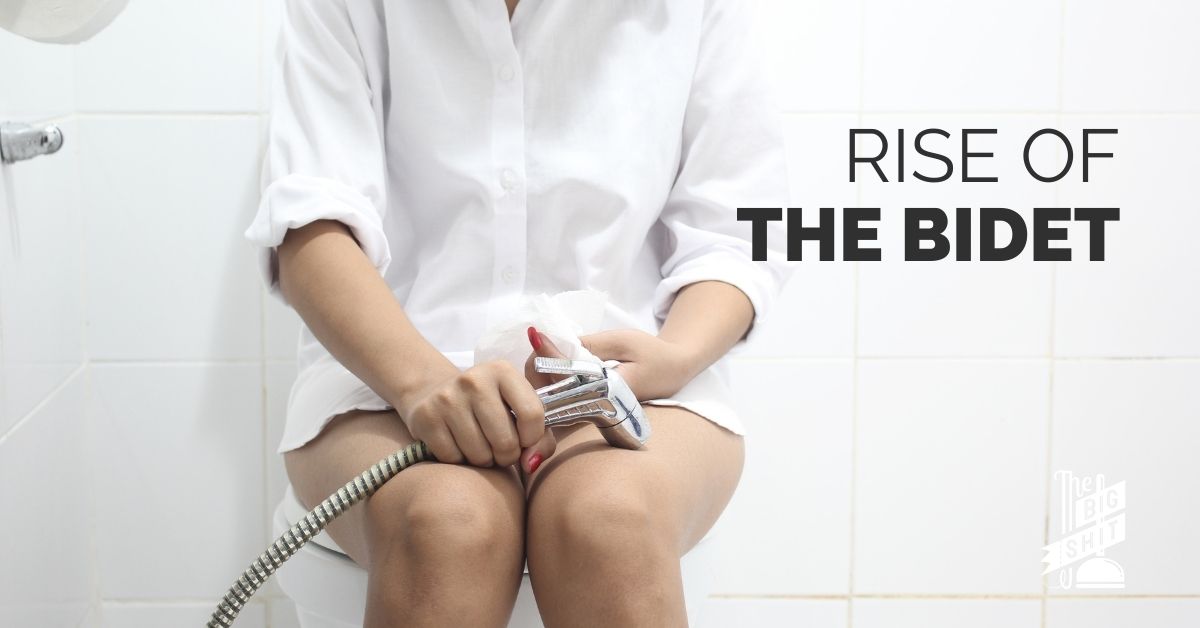
24 Jun The Rise of the Bidet
Picture if you will: bare toiletry shelves, empty toilet paper rolls, price gouging, fistfights in stores, and a panic-induced toilet paper-buying frenzy. No, this isn’t the Twilight Zone. This is 2020.
When COVID-19 hit the United States, the nation experienced extreme uncertainty as the pandemic began shutting down the economy. Americans – worried about lockdowns and supply shortages – rushed to the stores to stock up on essentials like toilet paper. This panic buying led to actual supply shortages leaving many people floating up shit creek without a paddle…and without anything to wipe with.
Soon, plumbers and municipal wastewater facilities began urging communities to avoid flushing items such as baby wipes, socks, cotton balls, sponges, and napkins as clogged sewer lines became commonplace.
With empty shelves and backed-up sewers, Americans desperately searched for alternatives. Many people flocked to an option already embraced throughout the world from Europe to Asia: the bidet.
It’s the End of the Roll as We Know It
Although America seems to have an inherent distrust and disdain for bidets, desperation led many Americans to take the plunge. Jason Ojalvo, CEO of TUSHY, a bidet company founded in 2015, shared how sales skyrocketed in 2020: “In the first week of March, ‘we saw sales starting to double what they had been the month prior. Then two days later they were triple what they usually are, and then suddenly it was 10 times what normal sales are. A few days later it peaked at a million-dollar sales per day.’”
Bidet manufacturers like TUSHY found themselves inundated with sales and began placing customer orders on a waiting list. People rushed to order bidets and bidet attachments for their homes, and there was an increase in sales for custom-home construction as well.
While the mad rush to buy bidets (or stock up on 540 rolls of toilet paper) has since subsided, bidet curiosity remains. The COVID-19 pandemic spurred conversation around general hygiene and made us rethink the way we clean our nether regions.
Don’t Fear the Smear: Bidets Clean Better
Heightened public health awareness led to conversations, news reports, and Google searches surrounding hygiene and cleanliness. This attention helped bolster the continued interest in bidets. As it turns out, bidets actually are a better cleaning alternative for our backsides.
Like bioBidet mentions, consider a mud-splattered mountain bike. Would you use dry toilet paper to clean it, or a stream of water? More than likely, you’d choose water…just as we do to wash our dishes, cars, hair, and bodies. Why? Water is simply more effective. Rather than smearing the mess, bidets use water to gently and effectively clean your undercarriage.
Saving Trees and Water is Flushing Awesome
While the rise of bidets provided a hygienic solution to our toilet paper problem, it also helped create environmental awareness. According to a report from Scientific American, one single roll of toilet paper requires 37 gallons of water to manufacture. A bidet, on the other hand, requires one-eighth of a gallon per use.
In addition to water, each roll of toilet paper uses 1.5 pounds of wood to produce – most of which comes from Canada’s Boreal Forests. 1.5 pounds may not seem like much until you consider that the average American uses 100 rolls of toilet paper per year. That’s a shit ton of wood – 150 pounds, to be exact – that each of us uses simply to wipe our bums!
Not only are bidets better for the environment, but using water can also benefit our health. Our skin absorbs toxins from products we use on our bodies – including toilet paper. White toilet paper is produced with over 100,000 different chemicals such as chlorine. Yikes.
Treat Your Butt: From Basic to Luxury
There are a number of bidet options on the market depending on your needs and wants.
Portable Bidets
Portable or travel bidets are the least expensive option for the sight-seeing ass. These bidets require the user to fill it up with water from a nearby faucet and then squeeze it by hand to clean themselves. The portability lets users take their bidet everywhere they go…quite literally. There are also battery-operated options that cost more, but they allow the user to sit back and relax instead of squeezing.
Bidet Attachments
For cheap asses, bidet attachments fit underneath a toilet seat and attach to the toilet bowl. While effective and inexpensive, they also have limited features. Some bidet attachments allow the user to have warm water, but you won’t find an air dryer or a remote control here.
Bidet Seats
For the average ass, a bidet seat replaces an existing toilet seat. Depending on whether you choose electric or non-electric, you can connect power to a water heater, a seat heater, a warm-air dryer, a remote, and even a fan-driven deodorizer.
Toilets with Built-In Bidets
Spoiled asses would likely enjoy toilets with built-in bidets. These all-in-one toilets are usually some of the most expensive, but for good reason. They come with remotes, allow the user to heat the water and the toilet seat, are equipped with warm air dryers, and have the best-angled jets.
Stand-Alone Bidets
Rich asses may prefer stand-alone bidets. These bidets are completely self-contained and are to be used only for cleaning after using a regular toilet. They are typically the most expensive and also take up the most space.
While not all Americans are ready to take the plunger, err…plunge, to a bidet, the COVID-19 pandemic certainly raised the curiosity about this worldly popular appliance, promising a cleaner and less wasteful future.
